| |
 |
 |
 |
| Comment on this report, or find other reports. |
 |
| Our Mystery Worshippers are volunteers who warm church pews for us around the world. If you'd like to become a Mystery Worshipper, start here. |
 |
| Find out how to reproduce this report in your church magazine or website. |
|
|
| 3044: St Andrew, Didling, England |
 |
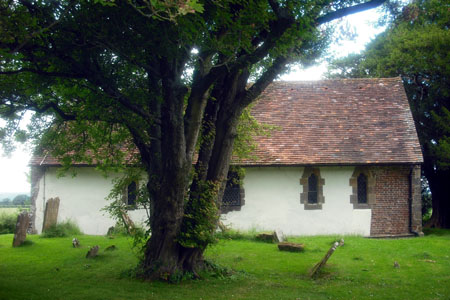 |
 |
Mystery Worshipper: Teutonic Knight.
The church: St Andrew, Didling, West Sussex, England.
Denomination: Church of England, Diocese of Chichester.
The building: It is almost entirely early English, dating to the first part of the 13th century. The single bell is said to date from 1587. Half way up the slope of Didling Hill, only a couple of hundred yards from the church, can be found a small quarry pit. Tradition has it that it was the source of at least some of the local building material. Major restoration work was completed last September. Outside, the north wall now literally glows with its new coat of white paint, while the south side, shielded by a number of splendid old trees and the slope of the Downs, is still waiting its turn. The interior seems to have been almost untouched by the passage of centuries. The Saxon font is one of the oldest in the country, and was hewn from local stone. The black oak beams and wooden benches are believed to be pre-Reformation (early 15th century) and must be among the oldest surviving examples of wooden congregational seating in Britain. The communion rails are Jacobean (17th century), along with the ornate pulpit, all carved in solid oak. The pulpit was made by a previous rector from an old chest, and the top ledge and lectern were added later to hide the keyhole. This little church is a time-warp that has avoided Victorian vandalism – oops, I mean restoration – and is still lit only by candles from a number of iron wall brackets and candelabras suspended from the oak beams. The churchyard has a number of ancient trees, among them a yew that narrowly escaped the workmen's saw in 1945. They had been called to lop off a branch that was damaging the roof, but instead proceeded to put their tools to the stem. A local farmer alerted the vicar, who narrowly averted disaster. The saw marks at the bottom of the trunk are still visible.
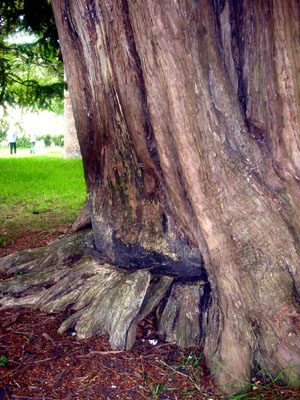
The church: This is the smallest of the four churches in the united benefice of South Harting & Elsted with Treyfor cum Didling. It is also known as the "Shepherd's Church" and is no longer used for weekly worship – there is, however, a monthly service during the summer months. In 2014 an appeal was launched to deal with some structural problems in the chancel floor and south wall. The money was raised within a very short period, which shows the affection in which this church is held by worshippers and the wider community. Many pilgrims, walkers on the South Downs Way, alight here and take rest in this little Shepherd's Church. The visitors' book is full of entries commenting on the beauty and peace that is found here.
The neighbourhood: Didling is a tiny village consisting of a farmstead and a few other smaller buildings north of the church. The area is popular with walkers. Uppark House, owned by the National Trust, is nearby. The most famous of its visitors was Emma Hart, born Amy Lyon, later Lady Hamilton and mistress of naval hero Admiral Lord Nelson. She is reputed to have danced naked on the dining room table to entertain the male guests of the lord of the manor. The writer HG Wells spent his boyhood here in the late 19th century, his mother being the housekeeper and his father a gardener on the estate. In 1989 the house was almost entirely gutted by a great fire, but has been painstakingly restored and is a shining example of period restoration work and research.
The cast: The Revd Mark Morton, rector. He donned a well-tailored cassock over his black clerical shirt and slacks, but wore neither surplice nor stole nor tippet.
The date & time: Eighth Sunday after Trinity, 16 July 2016, 6.00pm.
What was the name of the service?
Evensong.
How full was the building?
Twelve people, which made the small worship space look comfortably occupied. This number included at least two couples who were visiting, as well as locals and parishioners from the other churches in the benefice.
Did anyone welcome you personally?
We were quite early. The churchwarden chatted to us in a congenial manner while he was preparing the place for worship. We were also handed the prayer and hymn books as well as a sheet containing the musical settings of the canticles (unused – see below).
Was your pew comfortable?
These were dark oak benches rather than pews. The seats were very shallow but had a nice thick padded cushion covering the length. The high back rests looked like a solid door panel. They were surprisingly sophisticated and comfortable, and better than many of their more modern successors. There are also collapsible hinged boards at each pew end, which I would not be keen to use. The book ledges had been nibbled in places.
How would you describe the pre-service
atmosphere?
While the visitors were enjoying the peace in the churchyard and chatting to the vicar, the organist was setting up her keyboard. The churchwarden was lighting the candles (no electricity in the building) and then rang the single bell. When we responded to the call of the bell and went inside, there was a prayerful silence, only occasionally disturbed by the rustling of the sheet music that was being sorted into the right order by the musician.
What were the exact opening words of the
service?
"Well, good evening, and welcome to St Andrew’s here in Didling. Today is the eighth Sunday after Trinity."
What books did the congregation use during the
service?
Hymns Ancient and Modern, New Standard (words edition). These books were given in 1995 in memory of an American citizen who always "found peace here in this place." Also, the Book of Common Prayer. My copy had been marked with a paper clip between the Churching of Women and a psalm. I wondered when this particular copy had last been used.
What musical instruments were played?
A small electronic keyboard with organ stop was brought in, powered by a portable pack.
Did anything distract you?
A very fine needle-point depiction of a pastoral scene adorns the altar. Surrounded by bleating sheep in this church in a field, our eyes were drawn to it. We also wondered whether the numerous stump candles would last out the service. They did, and with an inch to spare. And then there was the question whether the clergy ever wear anything other than clerical black with no other adornments here.
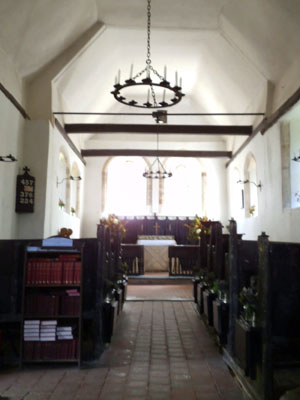
Was the worship stiff-upper-lip, happy clappy, or
what?
This was Prayer Book Sunday evening prayer with a short sermon where the congregation and psalmist speak Shakespeare's English, but the sermon and the Bible are in contemporary language. Although the service was advertised as "Evensong", the responses, canticles and psalm were said. We did, however, have three hymns. After the grace, the organist launched valiantly into a rendition of the aria "Lascia ch'io pianga" from Handel's opera Almira.
Exactly how long was the sermon?
8 minutes.
On a scale of 1-10, how good was the preacher?
7 – The rector was well-prepared and occasionally referred to notes, but spoke freely and sought eye-contact. It was a thoughtful but low-key sermon, and he had no distracting mannerisms at all. It was pleasantly unusual to be able to follow a sermon without the enhancement of an amplifier.
In a nutshell, what was the sermon
about?
It was an exposition on prayer. The New Testament makes it clear that prayer is good, and should be part of our lives the same as eating and drinking. It also teaches that prayer works. Prayer is necessary for building a personal relationship with God through Jesus Christ. Jesus himself tells his followers that anything asked for in his name will be given. However, we have to be careful not to focus on specific verses of scripture in order to "proof test." The experience of Jesus in the Garden of Gethsemane teaches us that prayer is not about "getting our own way" and being given what we ask for, but about submitting to the Father's will. Prayer does not change the will of God to satisfy our desires, but it changes us so that we can accept what is given, when it is given. As faithful disciples we need to walk through the narrow gate, not a rose garden. By seeking the will of God we will receive his grace. We need to accept it. Only then can we carry it into the world and help meet the needs of others.
Which part of the service was like being in
heaven?
The timelessness and intimate atmosphere of this tiny church, where the benches had been polished by half a millennium of local bottoms. It had been an overcast and sultry day with a few spots of rain, but during the offertory the sun broke through, lighting up the chancel, and we emerged into glorious evening sunshine.
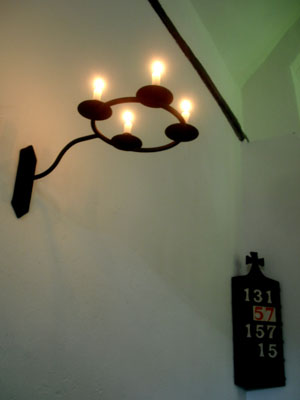
And which part was like being in... er... the other place?
The first hymn ("Love Divine") was played to the more dreary tune by Stainer rather than the uplifting Welsh Blaenwern by Rowlands. Also, the offertory hymn was one of the lesser known evening numbers, so we all struggled to find the right tune until the third verse.
What happened when you hung around after the service looking lost?
Having done all the talking before the service and emerging into the glorious early evening sunshine, we departed carrying the peace of this place home with us. Even the treacherous narrow lane with high hedges either side seemed less of a challenge.
How would you describe the after-service
coffee?
None.
How would you feel about making this church your regular (where 10 = ecstatic, 0 = terminal)?
9 – If we lived locally, this would be a given for the few services they have here throughout the year, though the treacherous approach along the narrow lane is rather nerve-wracking.
Did the service make you feel glad to be a
Christian?
It brought home the reality that "with the Lord one day is like a thousand years, and a thousand years are like one day" (2 Peter 3:8) and we carried this peace home with us.
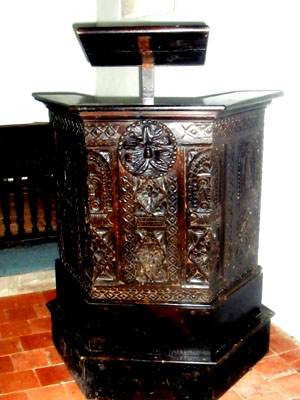
What one thing will you remember about all this in seven days' time?
This place, where time seems to have stood still since the Elizabethan settlement which brought with it the sense of being in the company of all the saints. |
|
|
 |
 |
 |
| We rely on voluntary donations to stay online. If you're a regular visitor to Ship of Fools, please consider supporting us. |
 |
 |
 |
| The Mystery Pilgrim |
 |
| One of our most seasoned reporters makes the Camino pilgrimage to Santiago de Compostela in Spain. Read here. |
 |
 |
 |
| London churches |
 |
| Read reports from 70 London churches, visited by a small army of Mystery Worshippers on one single Sunday. Read here. |
| |
|
|
|
|


